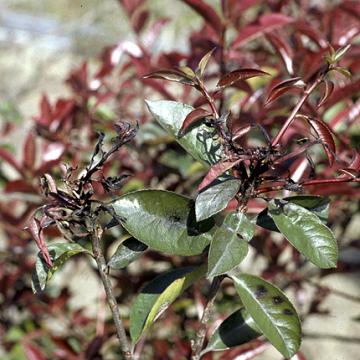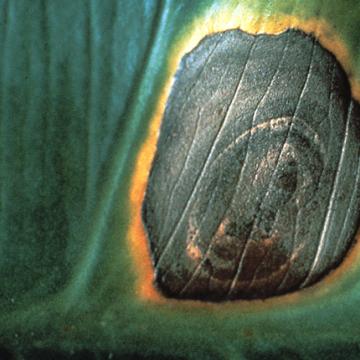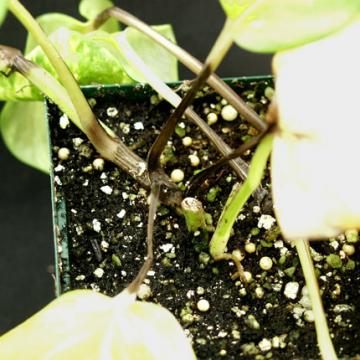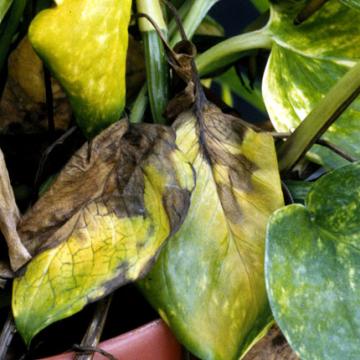DISEASE: Bacterial blight
HOST: Hazelnut
Diseased young tree with discoloration of the cambium. Dieback of young twigs and branches is characteristic. Other typical symptoms are bud and twig necrosis and small, angular or round, water-soaked leaf spots.

Bacterial blight | Hazelnut
DISEASE: Bacterial blight
HOST: Hazelnut (Corylus americana)
PATHOGEN: Xanthomonas arboricola pv. corylina
SOURCE: J. Pscheidt
DISEASE: Bacterial blight
HOST: Photinia
Symptoms of photinia bud blight shown here are similar to those of blast of pear and apple, caused by Pseudomonas syringae pv. syringae.

Bacterial blight | Photinia
DISEASE: Bacterial blight
HOST: Photinia (Photinia glabra)
PATHOGEN: Pseudomonas syringae pv. photiniae
SOURCE: M. Goto
DISEASE: Bacterial canker
HOST: Hazelnut
Primary symptoms are failure of buds to break and withering and death of new foliage in spring. Dead leaves remain attached to limbs after normal leaf fall.

Bacterial canker | Hazelnut
DISEASE: Bacterial canker
HOST: Hazelnut (Corylus americana)
PATHOGEN: Pseudomonas syringae pv. avellanae
PATHOGEN SYNONYM: Pseudomonas avellanae
SOURCE: P. Psalidas
DISEASE: Bacterial leaf spot
HOST: Pothos
Leaf with black necrotic tissues with concentric rings of light and dark tissues.

Bacterial leaf spot | Pothos
DISEASE: Bacterial leaf spot
HOST: Pothos (Epipremnum pinnatum)
PATHOGEN: Pseudomonas cichorii
SOURCE: APS
DISEASE: Bacterial wilt
HOST: Pothos
Pothos with infected stem and petioles.
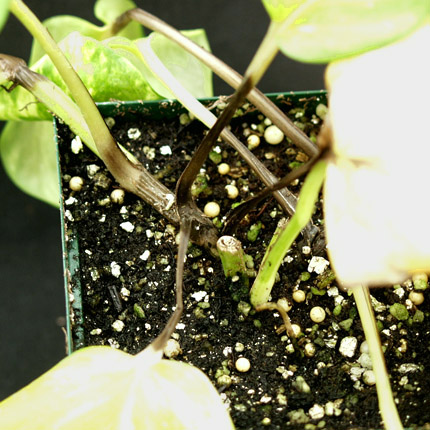
Bacterial wilt | Pothos
DISEASE: Bacterial wilt
HOST: Pothos (Epipremnum aureum)
PATHOGEN: Ralstonia solanacearum
PATHOGEN SYNONYM: Pseudomonas solanacearum
SOURCE: D. Norman
DISEASE: Bacterial wilt
HOST: Pothos
Plant with severely infected leaves and stems.
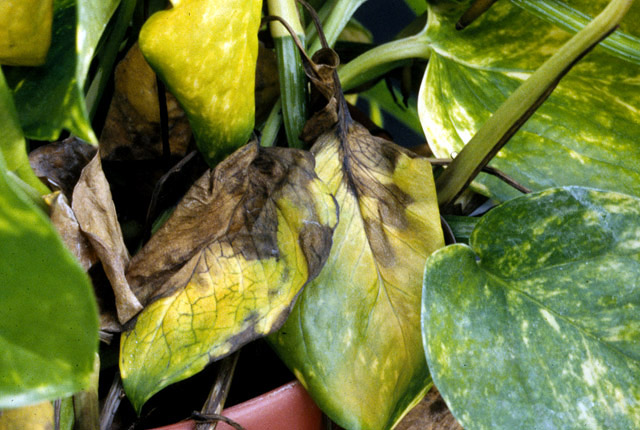
Bacterial wilt | Pothos
DISEASE: Bacterial wilt
HOST: Pothos (Epipremnum aureum)
PATHOGEN: Ralstonia solanacearum
PATHOGEN SYNONYM: Pseudomonas solanacearum
SOURCE: D. Norman
DISEASE: Fire blight
HOST: Photinia
Fire blight cankers on photinia.

Fire blight | Photinia
DISEASE: Fire blight
HOST: Photinia (Photinia fraseri)
PATHOGEN: Erwinia amylovora
SOURCE: M. Schroth



